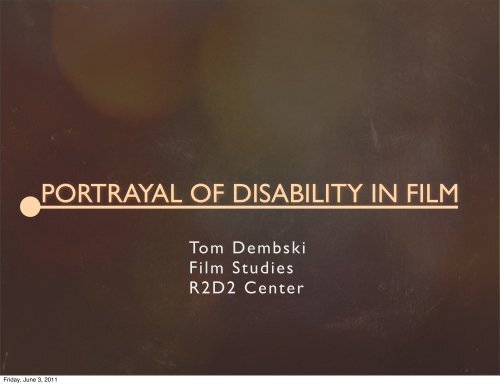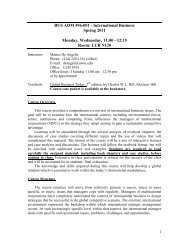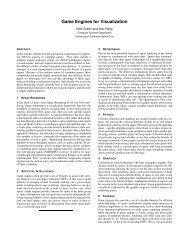PORTRAYAL OF DISABILITY IN FILM - The Study Stream
PORTRAYAL OF DISABILITY IN FILM - The Study Stream
PORTRAYAL OF DISABILITY IN FILM - The Study Stream
Create successful ePaper yourself
Turn your PDF publications into a flip-book with our unique Google optimized e-Paper software.
<strong>PORTRAYAL</strong> <strong>OF</strong> <strong>DISABILITY</strong> <strong>IN</strong> <strong>FILM</strong><br />
Tom Dembski<br />
Film Studies<br />
R2D2 Center<br />
Friday, June 3, 2011
<strong>PORTRAYAL</strong> <strong>OF</strong> <strong>DISABILITY</strong> <strong>IN</strong> <strong>FILM</strong><br />
Victimized/Patronized<br />
Demonized<br />
Marginalized<br />
Sensationalized<br />
Normalized<br />
Friday, June 3, 2011
Victimized/Patronized<br />
“Burden, childlike or incompetent; the role of the person<br />
<strong>PORTRAYAL</strong> <strong>OF</strong> <strong>DISABILITY</strong> <strong>IN</strong> <strong>FILM</strong><br />
with a disability is meant for the viewer to feel sorry for by<br />
creating the “those poor people” effect. Often portrayed as<br />
unable to live a normal, successful life. Seldom shown in<br />
situations evolving positive social interactions, rather a strain to<br />
other people, or the person cannot bear the disability. Most<br />
cases the person needs to learn to become accustomed to the<br />
disability, if that “lesson” is not learned the person often seeks<br />
death over life.”<br />
Friday, June 3, 2011
Demonized<br />
“Sinister, evil, mournful; the person is portrayed as a<br />
<strong>PORTRAYAL</strong> <strong>OF</strong> <strong>DISABILITY</strong> <strong>IN</strong> <strong>FILM</strong><br />
criminal or less than human due to a disability or deformity,<br />
often seeking revenge or to punish able-body people. Most<br />
likely the person is portrayed as bitter and an outcast from the<br />
rest of the characters and there is a group effort to destroy the<br />
person rather than helping.”<br />
Friday, June 3, 2011
Marginalized<br />
“Humiliate, demean; a person is portrayed in a<br />
<strong>PORTRAYAL</strong> <strong>OF</strong> <strong>DISABILITY</strong> <strong>IN</strong> <strong>FILM</strong><br />
condescending way and cannot live a normal life due to other<br />
people keeping the individual down. Often the person, due to a<br />
disability, cannot fit into society without proving that they are<br />
just as able as everyone else. Although the disability is apparent,<br />
that is not the focus, rather it is on how the individual must<br />
overcome society and stereotypes that prevent people with<br />
disabilities to live life to its fullest.”<br />
Friday, June 3, 2011
Sensationalized<br />
“Super Crip, heroic, superstar; a person is portrayed as<br />
<strong>PORTRAYAL</strong> <strong>OF</strong> <strong>DISABILITY</strong> <strong>IN</strong> <strong>FILM</strong><br />
overcoming their disability do to extraordinary measures or<br />
unusual talent, that separates them from the rest of the disability<br />
population. Although the film focuses on the disability, it is<br />
portrayed as something that needs overcoming to prove to the<br />
main character or other character life’s worth.”<br />
Friday, June 3, 2011
Normalized<br />
“Rational, accustomed, familiar; the disability of not the<br />
<strong>PORTRAYAL</strong> <strong>OF</strong> <strong>DISABILITY</strong> <strong>IN</strong> <strong>FILM</strong><br />
focus of the film and little attention is brought to the disability,<br />
but it is apparent that the character has a disability. <strong>The</strong> Person<br />
is shown living a life very similar to the rest of the characters<br />
dealing with the same struggles and triumphs, not disabilities.”<br />
Friday, June 3, 2011
<strong>PORTRAYAL</strong> <strong>OF</strong> <strong>DISABILITY</strong> <strong>IN</strong> <strong>FILM</strong><br />
• Portrayal<br />
• Appearance and charter of a person<br />
• Dramatic representation<br />
• AT<br />
• Assitive technology. Anything that aids people<br />
Friday, June 3, 2011
Prior to Film<br />
<strong>PORTRAYAL</strong> <strong>OF</strong> <strong>DISABILITY</strong> <strong>IN</strong> <strong>FILM</strong><br />
Disability as entertainment:<br />
• Literature<br />
• Hunchback of Notre Dame (1831)<br />
• Christmas Carol (1843)<br />
• Moby Dick (1851)<br />
• Sideshows/Freak shows<br />
Friday, June 3, 2011
Prior to Film<br />
<strong>PORTRAYAL</strong> <strong>OF</strong> <strong>DISABILITY</strong> <strong>IN</strong> <strong>FILM</strong><br />
Disability as entertainment:<br />
• “Freak shows” became a popular profession for<br />
citizens with physical disabilities<br />
Friday, June 3, 2011
Prior to Film<br />
<strong>PORTRAYAL</strong> <strong>OF</strong> <strong>DISABILITY</strong> <strong>IN</strong> <strong>FILM</strong><br />
Disability as entertainment:<br />
• “Freak shows” became a popular profession for<br />
citizens with physical disabilities<br />
• Around the 1920’s Freak shows would see a decline<br />
• Science<br />
• Law<br />
• Film<br />
Friday, June 3, 2011
Invention of Film<br />
<strong>PORTRAYAL</strong> <strong>OF</strong> <strong>DISABILITY</strong> <strong>IN</strong> <strong>FILM</strong><br />
Film as entertainment:<br />
• Film attracted many spectators to a new form of<br />
entertainment<br />
• <strong>The</strong> invention of film allowed pioneers to bring the world<br />
to every city with a theater<br />
• Film became the main form of entertainment by the 1920’s<br />
Friday, June 3, 2011
1920-30’s<br />
<strong>PORTRAYAL</strong> <strong>OF</strong> <strong>DISABILITY</strong> <strong>IN</strong> <strong>FILM</strong><br />
Spectacle and Grotesque:<br />
• <strong>The</strong> “monster-cycle” of Universal studios from 1923-1960<br />
• Focused on the fantastic and gruesome. Often physical<br />
deformities focuses created the horror<br />
Films included:<br />
• <strong>The</strong> Hunchback of Notre Dame (1923)<br />
• Frankenstein (1931)<br />
• Freaks (1932)<br />
Other films:<br />
• West of Zanzibar (1928)<br />
• Moby Dick (1930)<br />
Friday, June 3, 2011
1920-30’s<br />
<strong>PORTRAYAL</strong> <strong>OF</strong> <strong>DISABILITY</strong> <strong>IN</strong> <strong>FILM</strong><br />
Spectacle and Grotesque:<br />
Freaks (1932)<br />
• In attempts to cash in on Universal Studios success, MGM<br />
hired Universal Studios Dracula director Tod Browning to<br />
head “monster” film.<br />
• <strong>The</strong> film did not do well in theaters and other studios<br />
took it as a warning to stick to less “controversial”<br />
material during the depression<br />
Friday, June 3, 2011
1920-30’s<br />
<strong>PORTRAYAL</strong> <strong>OF</strong> <strong>DISABILITY</strong> <strong>IN</strong> <strong>FILM</strong><br />
Spectacle and Grotesque:<br />
Freaks (1932)<br />
Friday, June 3, 2011
1940’s<br />
<strong>PORTRAYAL</strong> <strong>OF</strong> <strong>DISABILITY</strong> <strong>IN</strong> <strong>FILM</strong><br />
War time:<br />
• Following every other industry in America, Hollywood<br />
helped with the war effort by producing war time films,<br />
documentaries, and propaganda films.<br />
• Many important directors and actors of the time<br />
participated<br />
• Did so well doing their part in war efforts, that by not<br />
participating looked anti-America and a career killer<br />
Friday, June 3, 2011
1940’s<br />
<strong>PORTRAYAL</strong> <strong>OF</strong> <strong>DISABILITY</strong> <strong>IN</strong> <strong>FILM</strong><br />
War time:<br />
• Following the end of the war, many films depicted<br />
characters with disabilities resulting from the war.<br />
• <strong>The</strong>se portrayals were some of the first to show people<br />
with disabilities as “true to life”<br />
Films included:<br />
• Pride of the Marines (1945)<br />
• Till the End of Time (1946)<br />
• <strong>The</strong> Best Years of Our Lives (1946)<br />
Friday, June 3, 2011
1940’s<br />
<strong>PORTRAYAL</strong> <strong>OF</strong> <strong>DISABILITY</strong> <strong>IN</strong> <strong>FILM</strong><br />
War time:<br />
<strong>The</strong> Best Years of Our Lives (1946)<br />
• A film that dealt with current struggles of men returning<br />
to civilian life following WWII<br />
• <strong>The</strong> film includes physical disabilities, alcoholism, and<br />
depression<br />
• Important that the film did not only focus on disability, nor<br />
was the man with the prostheses the only returning vet in<br />
the film to encounter problems<br />
Friday, June 3, 2011
1950’s<br />
<strong>PORTRAYAL</strong> <strong>OF</strong> <strong>DISABILITY</strong> <strong>IN</strong> <strong>FILM</strong><br />
Consumerism:<br />
•<br />
•<br />
Friday, June 3, 2011
1960’s<br />
<strong>PORTRAYAL</strong> <strong>OF</strong> <strong>DISABILITY</strong> <strong>IN</strong> <strong>FILM</strong><br />
Civil rights and Vietnam War:<br />
• Just as America went through major changes, so did<br />
Hollywood.<br />
• Hollywood saw a shift from once popular forms of cinema<br />
to now competing with T.V., foreign films, and independent<br />
cinema.<br />
• Disability wise, films were both positive and negative, the<br />
negative out weighing the positive<br />
Friday, June 3, 2011
1960’s<br />
<strong>PORTRAYAL</strong> <strong>OF</strong> <strong>DISABILITY</strong> <strong>IN</strong> <strong>FILM</strong><br />
Civil rights and Vietnam War:<br />
Negative<br />
• James Bond Dr. No (1962)<br />
• <strong>The</strong> Miracle Worker (1962)<br />
• Whatever Happened to Baby Jane (1962)<br />
• Dr. Strangelove (1963)<br />
• Wait until Dark (1967)<br />
• Charly (1968)<br />
Positive<br />
• <strong>The</strong> Heart is a Lonely Hunter (1968)<br />
Friday, June 3, 2011
1960’s<br />
<strong>PORTRAYAL</strong> <strong>OF</strong> <strong>DISABILITY</strong> <strong>IN</strong> <strong>FILM</strong><br />
Civil rights and Vietnam War:<br />
Whatever Happened to Baby Jane (1962)<br />
• Another horror/thriller film that included physical disability<br />
• <strong>The</strong> film was not projected to do as well as it did, gaining<br />
both critical and commercial success.<br />
• A film that incorporated many things; mental instability,<br />
physical disability<br />
• After an accident leaving Blanche paralyzed from the waist down her<br />
acting career is over. Her sister is the only one left to take care of her<br />
but resenting the fact that Blanche is the only remembered Hudson,<br />
despite Blanches (Joan Crawford) departure from acting for several<br />
years, Baby Jane (Bette Davis) keeps Blanche secluded in their house<br />
controlling her life. Blanche accepts this, presumably because of Jane’s<br />
alcoholism and mental instability.<br />
Friday, June 3, 2011
1960’s<br />
<strong>PORTRAYAL</strong> <strong>OF</strong> <strong>DISABILITY</strong> <strong>IN</strong> <strong>FILM</strong><br />
Civil rights and Vietnam War:<br />
Whatever Happened to Baby Jane (1962)<br />
Friday, June 3, 2011
1970’s<br />
<strong>PORTRAYAL</strong> <strong>OF</strong> <strong>DISABILITY</strong> <strong>IN</strong> <strong>FILM</strong><br />
Post-Vietnam War:<br />
• As with WWII, the Vietnam War brought home many disabled<br />
vets.<br />
• Since the war was so unpopular, many filmmakers used<br />
disability as a way to prove the war wrong (early 1970’s).<br />
Others used disability to tell new stories seldom depicted in<br />
film.<br />
• <strong>The</strong>se films were mostly positive, depicting the<br />
independent life<br />
Friday, June 3, 2011
1970’s<br />
<strong>PORTRAYAL</strong> <strong>OF</strong> <strong>DISABILITY</strong> <strong>IN</strong> <strong>FILM</strong><br />
Post-Vietnam War:<br />
• Tell Me that You Love Me, Junie Moon (1970)*<br />
• Johnny Got his Gun (1971)<br />
• A Day in the Death of Joe Egg (1971)<br />
• Butterflies are Free (1972)*<br />
• One Flew Over the Cukoo’s Nest (1975)*<br />
• Coming Home (1978)*<br />
• Best Boy (1979)*<br />
• Apocalypse Now (1979)<br />
Friday, June 3, 2011
1970’s<br />
<strong>PORTRAYAL</strong> <strong>OF</strong> <strong>DISABILITY</strong> <strong>IN</strong> <strong>FILM</strong><br />
Post-Vietnam War:<br />
Johnny Got his Gun (1971)<br />
• Negative portrayal of disability<br />
• A soldier hit by an artillery shell is left severely disabled and disfigured.<br />
Losing control of both arms and legs, Joe is confined to a hospital bed.<br />
Because of the explosion Joe has also lost his sight, his nose, his ears, and<br />
mouth. Unable to communicate with anyone, the movie depicts Joe trapped<br />
in his own body, prisoner like. From then on Joe goes in and out of<br />
fantasies, mostly memories of when he was able-bodied. Joe hates his life, so<br />
much that he wishes to die, but is unable to tell anyone. A nurse that has<br />
been taken care of him from the start feels sorry for Joe and tries to<br />
euthanize him but is stopped before Joe dies. Awarded Grand Prix at Cannes<br />
Film Festival.<br />
Friday, June 3, 2011
1970’s<br />
<strong>PORTRAYAL</strong> <strong>OF</strong> <strong>DISABILITY</strong> <strong>IN</strong> <strong>FILM</strong><br />
Post-Vietnam War:<br />
Johnny Got his Gun (1971)<br />
Friday, June 3, 2011
1970’s<br />
<strong>PORTRAYAL</strong> <strong>OF</strong> <strong>DISABILITY</strong> <strong>IN</strong> <strong>FILM</strong><br />
Post-Vietnam War:<br />
Coming Home (1978)<br />
• Positive portrayal of disability<br />
• A married women volunteers at a local veterans hospital where she meets<br />
Luke, a man left bitter, angry, and paralyzed by <strong>The</strong> Vietnam War. <strong>The</strong> two<br />
know each other from high school and start to reacquaint with one another<br />
while Luke is at the hospital. After being released from the hospital and his<br />
many conversations with Sally, his outlook on life is more positive and he<br />
pursues a more personal relationship. <strong>The</strong> two start have many happy times,<br />
eventually falling in love. Won three Academy Awards including best actor (Jon<br />
Voigt) and best writing.<br />
Friday, June 3, 2011
1970’s<br />
<strong>PORTRAYAL</strong> <strong>OF</strong> <strong>DISABILITY</strong> <strong>IN</strong> <strong>FILM</strong><br />
Post-Vietnam War:<br />
Coming Home (1978)<br />
Friday, June 3, 2011
1980’s<br />
<strong>PORTRAYAL</strong> <strong>OF</strong> <strong>DISABILITY</strong> <strong>IN</strong> <strong>FILM</strong><br />
High-concept:<br />
• <strong>The</strong> 80’s produced many diverse films pertaining to disability.<br />
• Elephant Man (1980)<br />
• Who’s Life is it Anyways (1981)<br />
• If You Could See What I Hear (1982)<br />
• Children of a Lesser God (1986)<br />
• Monkey Shines (1988)<br />
• Born on the Fourth of July (1989)<br />
• Driving Miss Daisy (1989)<br />
Friday, June 3, 2011
1980’s<br />
<strong>PORTRAYAL</strong> <strong>OF</strong> <strong>DISABILITY</strong> <strong>IN</strong> <strong>FILM</strong><br />
High-concept:<br />
• Following the success of the 1970’s ‘Blockbusters”, the 80’s<br />
expanded this, making film for a wider audience.<br />
• Many movies could be summed up in two sentences, and were<br />
made with less thinking/more action<br />
• Often these films used futuristic technology, many involving<br />
disabilities.<br />
• Empire Strikes Back (1980)<br />
• Return of the Jedi (1983)<br />
• Robocop (1987)<br />
• Evil Dead II (1987)<br />
Friday, June 3, 2011
1980’s<br />
<strong>PORTRAYAL</strong> <strong>OF</strong> <strong>DISABILITY</strong> <strong>IN</strong> <strong>FILM</strong><br />
High-concept:<br />
High Tech Assistive Technology<br />
Friday, June 3, 2011
1990’s<br />
<strong>PORTRAYAL</strong> <strong>OF</strong> <strong>DISABILITY</strong> <strong>IN</strong> <strong>FILM</strong><br />
Mainstream and Indie Film:<br />
• High-concept and Blockbuster film formulas were used to create<br />
the hugely popular and high grossing “mainstream” film.<br />
• <strong>The</strong> 90’s also allowed for independent filmmakers to break into<br />
the market with low budgets due to video recording, digital<br />
editing, digital soundtracks, and the Internet.<br />
Friday, June 3, 2011
1990’s<br />
<strong>PORTRAYAL</strong> <strong>OF</strong> <strong>DISABILITY</strong> <strong>IN</strong> <strong>FILM</strong><br />
Mainstream and “Indie” Film:<br />
• America also saw a hugh import of foreign films that broke into<br />
the mainstream audience<br />
• Due to the contrast of movie production, many different types of<br />
movies involving disabilities were made, from the feel goods, to<br />
more realistic depictions, to negative portrayals.<br />
Friday, June 3, 2011
1990’s<br />
<strong>PORTRAYAL</strong> <strong>OF</strong> <strong>DISABILITY</strong> <strong>IN</strong> <strong>FILM</strong><br />
Mainstream<br />
Mainstream and “Indie” Film:<br />
• Sent of a Woman (1992)<br />
• Forest Gump (1994)<br />
• Toy Story (1995)<br />
• Gattaca (1997)<br />
• Bone Collector (1999)<br />
• Wild, Wild West (1999)<br />
Indie<br />
• <strong>The</strong> Water Dance (1992)<br />
• Passion Fish (1992)<br />
• Boxing Helena (1993)<br />
• <strong>The</strong> <strong>The</strong>ory of Flight (1998)<br />
Foreign<br />
• <strong>The</strong> Piano (1993) New Zealand<br />
• Rumble in the Bronx (1995) Hong Kong<br />
• Breaking Waves (1996) Denmark<br />
• Live Flesh (1997) Spain<br />
• Dance me to My Song (1998) Australia<br />
• <strong>The</strong> Color of Paradise (1999) Iran<br />
Friday, June 3, 2011
2000’s and Today<br />
<strong>PORTRAYAL</strong> <strong>OF</strong> <strong>DISABILITY</strong> <strong>IN</strong> <strong>FILM</strong><br />
Digital and Alternative:<br />
• Digital production and distribution lead to more people watching<br />
movies than ever before.<br />
• Digital effects had more movie power than stars<br />
• each studio tried outdoing each other in effects<br />
• Still have the mainstream formula and independent film makers,<br />
but a hybrid of the two formed to create a more popular form<br />
of alternative cinema.<br />
Friday, June 3, 2011
2000’s and Today<br />
<strong>PORTRAYAL</strong> <strong>OF</strong> <strong>DISABILITY</strong> <strong>IN</strong> <strong>FILM</strong><br />
Digital and Alternative:<br />
• With many studios trying to out do each other with digital<br />
effects, many mainstream films did not focus on story or original<br />
screen plays.<br />
• This left independent and alternative films to focus more on<br />
simple, yet effective movies.<br />
• However, in both categories, a more normalized trend took hold<br />
in cinema overall<br />
Friday, June 3, 2011
2000’s and Today<br />
<strong>PORTRAYAL</strong> <strong>OF</strong> <strong>DISABILITY</strong> <strong>IN</strong> <strong>FILM</strong><br />
Digital and Alternative:<br />
• Training Day (2001)<br />
• X-men (2001)<br />
• Rory O’Shea was Here (2004)<br />
• Saved (2004)<br />
• Inside Man (2006)<br />
• How to Train Your Dragon (2010)<br />
Friday, June 3, 2011
Children Movies<br />
<strong>PORTRAYAL</strong> <strong>OF</strong> <strong>DISABILITY</strong> <strong>IN</strong> <strong>FILM</strong><br />
What children movies have you seen<br />
Victimized/Patronized<br />
Demonized<br />
Marginalized<br />
Sensationalized<br />
Normalized<br />
Friday, June 3, 2011
Children Movies<br />
<strong>PORTRAYAL</strong> <strong>OF</strong> <strong>DISABILITY</strong> <strong>IN</strong> <strong>FILM</strong><br />
• Since the introduction of full-length children movies there has<br />
been disabilities.<br />
• Most of the disabilities portrayed have been negative<br />
Friday, June 3, 2011












